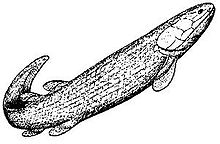Rhipidistia: Difference between revisions
Content deleted Content added
m →top: http→https for Google Books and Google News using AWB |
No edit summary |
||
| Line 11: | Line 11: | ||
*[[Tetrapodomorpha]] |
*[[Tetrapodomorpha]] |
||
}} |
}} |
||
The '''Rhipidistia''', also known as dipnotetrapodomorphs (formally Dipnotetrapodomorpha)<ref name="Nelson2006">{{cite book|last=Joseph S.|first=Nelson|authorlink=Joseph S. Nelson|title=Fishes of the World|url=https://books.google.com/books?id=exTV-GLnCB4C&pg=PA461|accessdate=9 May 2015|date=19 May 2006|publisher=John Wiley & Sons|isbn=978-0-471-75644-6|page=461}}</ref> are a clade of [[lobe-finned fish]]es which include the [[ |
The '''Rhipidistia''', also known as dipnotetrapodomorphs (formally Dipnotetrapodomorpha)<ref name="Nelson2006">{{cite book|last=Joseph S.|first=Nelson|authorlink=Joseph S. Nelson|title=Fishes of the World|url=https://books.google.com/books?id=exTV-GLnCB4C&pg=PA461|accessdate=9 May 2015|date=19 May 2006|publisher=John Wiley & Sons|isbn=978-0-471-75644-6|page=461}}</ref> are a clade of [[lobe-finned fish]]es which include the [[tetrapods]] and [[lungfishes]]. Rhipidistia formerly referred to a subgroup of Sarcopterygii consisting of the [[Porolepiformes]] and [[Osteolepiformes]], a definition that is now obsolete.<ref name="Age Rhipidistia lived in">{{cite web|title=Encyclopedia Britannica|url=http://www.britannica.com/EBchecked/topic/501438/Rhipidistia|accessdate=3 April 2014}}</ref> However as cladistic understanding of the vertebrates has improved over the last few decades a monophyletic Rhipidistia is now understood to include the whole of [[Tetrapoda]] and of the extant [[lungfishes]]. |
||
==Relationships== |
==Relationships== |
||
Revision as of 02:45, 9 February 2017
| Rhipidistians | |
|---|---|

| |
| Ectosteorhachis | |
| Scientific classification | |
| Domain: | Eukaryota |
| Kingdom: | Animalia |
| Phylum: | Chordata |
| Clade: | Sarcopterygii |
| Clade: | Rhipidistia |
| Subgroups | |
The Rhipidistia, also known as dipnotetrapodomorphs (formally Dipnotetrapodomorpha)[1] are a clade of lobe-finned fishes which include the tetrapods and lungfishes. Rhipidistia formerly referred to a subgroup of Sarcopterygii consisting of the Porolepiformes and Osteolepiformes, a definition that is now obsolete.[2] However as cladistic understanding of the vertebrates has improved over the last few decades a monophyletic Rhipidistia is now understood to include the whole of Tetrapoda and of the extant lungfishes.
Relationships
The cladogram presented below is based on studies compiled by Philippe Janvier and others for the Tree of Life Web Project,[3] Mikko's Phylogeny Archive[4] and Swartz 2012.[5]
| Sarcopterygii |
| ||||||||||||||||||||||||
References
- ^ Joseph S., Nelson (19 May 2006). Fishes of the World. John Wiley & Sons. p. 461. ISBN 978-0-471-75644-6. Retrieved 9 May 2015.
- ^ "Encyclopedia Britannica". Retrieved 3 April 2014.
- ^ Janvier, Philippe. 1997. Vertebrata. Animals with backbones. Version 01 January 1997 (under construction). http://tolweb.org/Vertebrata/14829/1997.01.01 in The Tree of Life Web Project, http://tolweb.org/
- ^ Haaramo, Mikko (2003). "Sarcopterygii". in Mikko's Phylogeny Archive. Retrieved November 4, 2013.
- ^ Swartz, B. (2012). "A marine stem-tetrapod from the Devonian of Western North America". PLoS ONE. 7 (3): e33683. doi:10.1371/journal.pone.0033683. PMC 3308997. PMID 22448265.
{{cite journal}}: CS1 maint: unflagged free DOI (link)
